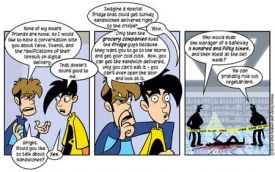|
|
 |
Created in 1998 by writer Jerry Holkins and artist Mike Krahulik, Penny Arcade is as much a blog as a comic strip. It’s published three times a week, on Mondays, Wednesdays and Fridays at PennyArcade.com and has a large following. The audience that reads Penny Arcade religiously every week is different than the traditional one that follows comic books. Yet, Penny Arcade shows that there are genuine interests in comic books and comic strips when one is not caught in format wars.
There are several points which make Penny Arcade a phenomenon worth watching.
 Penny Arcade - November 18 1998 |
1-Penny Arcade follows the traditional comic book model of mixing a strip with a column and readers’ letters. In many comic books until the mid 1990s, editors and publishers had their own soap boxes where they communicated with their readers like Stan Lee, editor-in-chief at Marvel Comics and his Bullpen Bulletins. Penny Arcade accepts blog comments from readers which make the experience of reading the comic strip more than looking at it. One has to read the editorials by the authors and read comments as well to get a full experience.
2-Penny Arcade uses a three panel layout which limits the storytelling to the introduction, the conflict, and a merger of both the climax and the resolution. Normally, to achieve a minimum storytelling structure, the four basic points of a story would be required. At Penny Arcade, the layout of the stories is spread consistently over three panels, which means that sometimes, the climax and the conflicts will be merged into one panel or the climax and the resolution will also be merged. It takes considerable skills to pull off this storytelling trick continually.
 Penny Arcade - October 15 2004 |
3-Penny Arcade’s readers have been trained to read the comic strip three times a week, just like print comic book readers have been trained to go to the comic book store every Wednesday. Consistency in delivery is important for maintaining a successful entertainment venue. That readers will willingly add a visit to Penny Arcade’s host Web site several times a week is a feat worth noting. Their habits have been conditioned by the offer the creators have put forward. Therefore, Penny Arcade is proving that comic book readers can be consuming your comics based on the frequency set by the creator. Thus, creating alternate models of delivery is still possible in Web comics.
4-The audience for Penny Arcade is not based on traditional comic book readers’ market and reaches an audience that many comic book publishers thought was lost to them forever because of competition from more “dynamic” forms of entertainments like video games and movies. Here, Penny Arcade provides a proof that there are a lot of potential comic book readers around. It’s just that the existing product offering was not suited to their tastes. These readers will read a comic strip, and reach out to it several times per weeks, provided it is delivered in a format that suits them.
5-The Comic strip format may be weakening in newspapers around the world, but they seem to be better forms of sequential art to be delivered on electronic media, than comic books. Comic strips are short and limited in panels. Stories can have long continuities or none at all, or a mix of both, like Penny Arcade. Comic books on the other hand, tend to pack more contents per units than comic strips. They are longer read and have more pages. Whereas one would not expect a comic strip to sell on its own daily, outside of another push vehicle, like a newspaper, Web comic strips are proving that on their own they have enough push to escape the need for a larger anchor like a portal. One would hardly imagine a traditional comic book format succeeding online. This means creators have to start thinking about comic strips instead of comic books when creating online comic books.
Penny Arcade is not the only Web comic strip related to video games. However, it shows that a new genre which would be deemed unviable in printed comics can thrive online.
 Penny Arcade - June 4 2008 |
© Copyright 2002-2019 by Toon Doctor Inc. - All rights Reserved. All other texts, images, characters and trademarks are copyright their respective owners. Use of material in this document (including reproduction, modification, distribution, electronic transmission or republication) without prior written permission is strictly prohibited.

